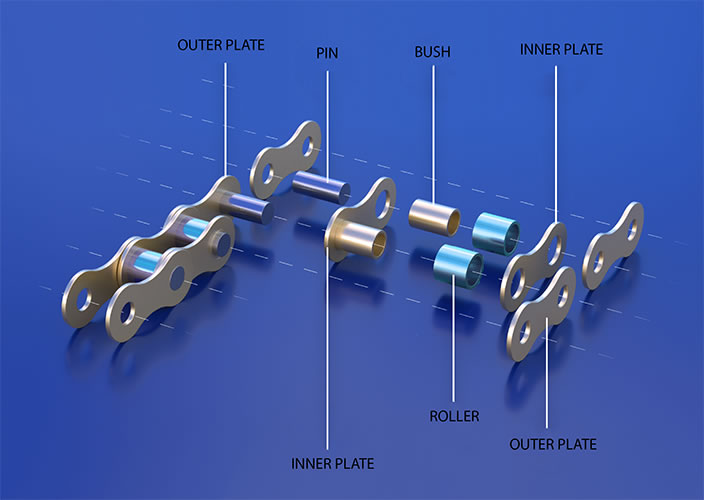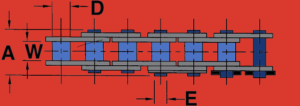
A roller chain is a type of chain drive that connects a toothed wheel (sprocket) to a camshaft, crankshaft, or other rotating machine part. Roller chains are most commonly used in machinery applications including roller chain conveyor industry, wire- and tube-drawing machines, printing presses, cars, motorcycles, and bicycles.
Roller chains consist of links connected to one another by rollers. A roller chain can be thought of as a series of short cylindrical rollers held together by side links. The roller chain is driven by an externally toothed wheel called a sprocket. Roller chains are simple, reliable, and efficient means of power transmission, giving transmission chains their agility and durability. Keep on reading to find out more about roller chains!
What is a roller chain?
Roller chains are also known as bush roller chains, and conveyor roller chains and they are open chains made up of flexible links that are connected by a pin. The bush roller chain is composed of an inner bush (bushing), an outer bush (roller), a pin, and a plate (link) which is shown in the diagram below. A roller chain is ordinarily hooked up using a master link which is called a “connecting link”. Another part which is a half link that is also known as “offset” is used to increase the length of the chain by a single roller.
A roller chain consists of two types of links: regular and offset links. The regular formation of a bush roller chain consists of an inner bush (bushing), an outer bush (roller), a pin, and a plate (link). A roller chain is ordinarily hooked up using a master link which is called a “connecting link”. Another part which is a half link that is also known as “offset” is used to increase the length of the chain by a single roller.
Roller chains also use attachments. The purpose of using roller chain attachments is to offer a wider range of capabilities for your roller chains.
What is the Function of a Roller Chain?
The primary function of a roller chain is to transmit rotational motion and power from one component to another. Roller chains are commonly used in applications where high torque and load capacities are required. By engaging with sprockets, they facilitate the movement of various mechanical systems, enabling machines to operate efficiently.
What is the Purpose of Roller Chains?
Roller chains serve several purposes, including:
- Power Transmission: They effectively transfer power from motors or engines to driven components, such as wheels or conveyor belts.
- Speed Reduction: Roller chains can be used to reduce the speed of a motor while increasing torque.
- Mechanical Linkage: They connect various components within a system, providing a reliable means of movement.
What are the Models of Roller Chains?
Roller chains come in various models and designs, each tailored for specific applications. Some common types include:
- Standard Roller Chains: The most common type, suitable for general-purpose use in various machinery.
- Heavy-Duty Roller Chains: Designed for high-load applications, these chains feature thicker links and stronger materials.
- Silent Roller Chains: Engineered to minimize noise during operation, making them ideal for applications where noise reduction is essential.
- Offset Link Chains: Used for applications requiring flexibility in tension adjustment.
In Which Industries are Roller Chains Used?
Roller chains are utilized across a wide range of industries, including:
- Manufacturing: Commonly found in assembly lines and conveyor systems.
- Agriculture: Used in farming equipment, such as tractors and harvesters.
- Automotive: Essential in vehicles for power transmission in various components.
- Mining: Employed in heavy machinery for transporting materials.
- Food Processing: Used in conveyor systems to move products through different stages of processing.
What is Chain Roller Used For?
Bicycle chains are a form of roller chain. A bicycle chain may have a master link or may require a chain tool for removal and installation. A similar but larger and thus stronger chain is used on most motorcycles although it is sometimes replaced by either a toothed belt or a shaft drive, which offers lower noise levels and fewer maintenance requirements.
The chain roller is a component of an automobile engine that drives the camshaft. The roller chain is made up of hundreds or thousands of small steel links that are threaded and interlocked to form a continuous loop. The roller chain is driven by a worm or gear, which engages the drive link on rotation. Some automobile engines use roller chains to drive the camshafts. Very high-performance engines often use gear drive, and starting in the early 1960s toothed belts were used by some manufacturers.
Chains are also used in forklifts using hydraulic rams as a pulley to raise and lower the carriage; however, these chains are not considered roller chains but are classified as lift or leaf chains. Chainsaw-cutting chains superficially resemble roller chains but are more closely related to leaf chains. They are driven by projecting the drive chain which also serves to locate the chain onto the bar.
What are the Advantages and Disadvantages of Roller Chains?
Advantages of Roller Chains:
- Durability: Roller chains are robust and can handle heavy loads over long periods.
- Efficiency: They provide a high level of power transmission efficiency with minimal energy loss.
- Versatility: Suitable for a wide range of applications, from light-duty to heavy-duty machinery.
Disadvantages of Roller Chains:
- Maintenance Requirements: Regular lubrication and maintenance are necessary to prevent wear and tear.
- Noise Generation: Depending on the application, roller chains can generate significant noise, which may be undesirable in some settings.
- Weight: Some roller chains can be heavier than alternative power transmission methods, which may impact the design of certain machinery.
What Should Be Considered When Choosing a Roller Chain?
Selecting the right roller chain is crucial for optimal performance in any application. Consider the following factors:
- Load Capacity: Ensure the chain can handle the expected load without failure.
- Speed Requirements: Choose a chain that can operate efficiently at the required speed.
- Environmental Conditions: Consider factors like temperature, moisture, and exposure to chemicals, which can affect chain performance.
- Compatibility: Ensure the chain is compatible with existing sprockets and machinery.
Maintenance and Lubrication of Roller Chains
A roller chain consists of a series of connected traveling metallic bearings which must be properly lubricated to obtain the maximum service life of the chain. Although many slow-speed drives operate successfully with little or no lubrication beyond the initial factory lubrication, proper lubrication will greatly extend the useful life of every chain drive.
Roller chains can be seen in different applications since their original material can be both metal and plastic, depending on what type of application they’re designed to be used. The main difference between roller chains and other kinds of chains is that they are lubricated through the pins and bushings themselves. This will leave you without the need of lubricating it every once in a while. All you need for your systems to have a longer life span is to keep dirt or grime away from it.
Roller chains that are typically made of a metal alloy however have low corrosion resistance and poor wear characteristics. This means that you need to use lubrication methods and substances to have a properly working system. Lubricants can be applied directly to chains, or they can be injected into the spaces between the outside link plate and the inside roller link plate.
What are the 2024 Prices of Roller Chains?
Prices for roller chains can vary significantly based on factors such as material, size, and brand. As of 2024, the price ranges are as follows:
- Standard Roller Chains: Typically range from $10 to $100, depending on the size and quality.
- Heavy-Duty Roller Chains: These may cost between $100 and $300, depending on their construction and load capacity.
- Specialty Chains (like Silent Roller Chains): Prices can vary widely, often ranging from $150 to $500 based on specifications and brand reputation.
What are the Sizes of Roller Chains?
Roller chains are available in various sizes, measured by the pitch (distance between the centers of two adjacent pins) and the width of the chain. Common sizes include:
- 1/4-inch Pitch: Suitable for light-duty applications.
- 3/8-inch Pitch: Commonly used in bicycles and small machinery.
- 1/2-inch Pitch: Standard size for many industrial applications.
- 3/4-inch and 1-inch Pitch: Used in heavy-duty applications requiring higher load capacities.
Get in touch with us to discover more usage areas of roller chains at Makelsan and get the service you need in your industry!


Roller chains are a type of chain drive that can be used on almost any vehicle. They work because they have a roller in the center that reduces friction between the chain and the sprockets, resulting in higher efficiency and less wear.
Roller chains use rollers instead of links to connect two sprockets together. This makes these chains more preferable as they can be designed at will to fit almost any type of application. Roller chains also reduce friction compared to simpler designs, resulting in higher efficiency and less wear on your vehicle’s parts.
To identify your roller chain’s size, mark it. Most roller chains have the size stamped right into the side plates. You may see something like “40”, also known as roller chain 40 “C2080H” or “10B” stamped in, which represents the industry number that represents the chain size. Chain sizes can vary from 35 roller chain, roller chain 50, roller chain 60 and to also 06b chain and 08b chain sizes, so you also see the related numbers on the side of the chain. Roller chain suppliers also produce size 60 roller chain and other sizes greater than 60 and they can be found in a broad range of applications, including light- to heavy-duty industrial grade. Old chains will most likely need to be cleaned in order to see this marking. Not every side plate has this marking, therefore you’ll need to clean several side plates before identifying a replacement roller chain.
You can simple measure your chain starting from both ends and divide it by two if you need the numbers for further installment.
Types of roller chains are available in different applications to meet a variety of needs. Roller chain manufacturers produce a wide range of roller chains to satisfy different clients from all sectors.
Standard: The standard roller chain is an economical choice for light loads and applications where the chain will be used in a moderate-duty environment.
Heavy Duty: Heavy-duty roller chains are designed to withstand higher loads than standard roller chains. They have a larger diameter, extra-long links, and thicker plates.
Double Pitch: Double-pitch roller chains are suitable for use with heavy loads or in environments where high wear resistance is required. They have two layers of roller chain links on either side of the main plate to provide higher strength against load stresses.
Hollow Pin: A hollow pin roller chain has a central pin that extends through the entire length of the chain. Hollow pin roller chains can be used with either standard or heavy-duty rolling elements and may also be used with leaf wheels for extra traction when braking.
Leaf: A leaf roller chain has leaf wheels at each end that allow it to turn easily but resist lateral forces from being pressed against an object under load. Leaf chains are most commonly used as part of a rack system with other components such as rollers or pins that allow
Silent Chain: A silent chain is one that is silent when it moves, which can be good for quiet environments.
Plastic Chain: A plastic chain is lightweight. That way, you can easily and confidently use it in areas where you need to limit the weight.
Specialty Chain: Specialty chains are great with other chains that you need to use in your application and also with another type of drive system, like a motor. This will widen your choice of equipment and vehicle as well.
Choosing the right material for a roller chain is crucial for ensuring its performance, durability, and suitability for specific applications. Here are some key materials commonly used in roller chains, along with their characteristics and considerations:
1. Steel
Steel is the most common material used for roller chains due to its strength and durability. It can withstand heavy loads and harsh conditions.
Advantages:
- High Strength: Steel chains can handle substantial torque and load.
- Versatility: Suitable for various applications, from light to heavy-duty machinery.
- Cost-Effective: Generally more affordable than specialty materials.
Disadvantages:
- Corrosion Susceptibility: Regular maintenance and lubrication are required to prevent rust.
- Weight: Steel chains can be heavier than alternatives, which may be a consideration in weight-sensitive applications.
2. Stainless Steel
Stainless steel roller chains offer excellent corrosion resistance, making them ideal for applications in moist or corrosive environments.
Advantages:
- Corrosion Resistance: Ideal for food processing, marine, and chemical industries.
- Hygienic: Non-reactive surface suitable for food applications.
- Aesthetic Appeal: Maintains a polished appearance over time.
Disadvantages:
- Higher Cost: Generally more expensive than standard steel chains.
- Lower Load Capacity: May not handle heavy loads as well as carbon steel chains.
3. Plastic
Plastic roller chains are lightweight and resistant to corrosion, making them suitable for specific applications where metal chains might be less effective.
Advantages:
- Lightweight: Reduces overall machinery weight, improving efficiency in some applications.
- Corrosion Resistant: Excellent for environments with chemicals or moisture.
- Low Noise: Operates quietly, beneficial in settings where noise reduction is essential.
Disadvantages:
- Limited Load Capacity: Generally not suitable for heavy-duty applications.
- Temperature Sensitivity: Can deform or degrade under extreme temperatures.
4. Composite Materials
Composite roller chains, which combine various materials such as plastics and fibers, can offer enhanced performance features.
Advantages:
- Enhanced Properties: Can be designed to be lightweight yet strong, combining benefits from different materials.
- Corrosion Resistance: Often resistant to a wide range of chemicals.
- Flexibility: Suitable for applications requiring a more flexible solution.
Disadvantages:
- Cost: Typically more expensive than standard chains.
- Availability: May be less readily available than traditional steel options.
Proper maintenance and repair of roller chains are critical to ensure their longevity and efficient operation. Here’s a detailed guide on how to effectively maintain and repair roller chains:
1. Regular Inspection
Frequent inspections are essential to catch any signs of wear or damage early.
- Visual Checks: Regularly examine the chain for signs of elongation, rust, or cracks.
- Functional Testing: Monitor the chain’s performance during operation. Listen for unusual noises that may indicate problems.
2. Cleaning
Keeping roller chains clean prevents debris from causing wear and ensures smooth operation.
- Debris Removal: Use a soft brush or cloth to remove dirt and grime. For stubborn debris, a suitable solvent may be needed.
- Avoid Harsh Chemicals: Use gentle cleaning agents to avoid damaging the chain.
3. Lubrication
Lubrication is vital for reducing friction and wear between moving parts.
- Choose the Right Lubricant: Use oils or greases specifically designed for roller chains. Follow manufacturer recommendations for the type and frequency of lubrication.
- Application: Apply lubricant directly to the chain while it is in motion to ensure even distribution. Avoid over-lubrication, as this can attract dirt.
4. Tension Adjustment
Maintaining proper tension is crucial for the chain’s performance and longevity.
- Check Tension Levels: Regularly assess the chain’s tension to ensure it is neither too tight nor too loose.
- Adjustment: Adjust the tension using the appropriate mechanisms (e.g., tensioners or slack adjusters) as needed.
5. Replacement of Worn Parts
Identifying and replacing worn or damaged components is vital to maintain chain performance.
- Identify Worn Links: Check for elongated links, damaged rollers, or other signs of wear.
- Replacement: Replace individual links or entire sections of the chain as necessary. Ensure replacements match the specifications of the original chain.
6. Professional Servicing
In some cases, it may be beneficial to seek professional assistance for maintenance or repairs.
- Expert Evaluation: Professional technicians can conduct thorough inspections and provide repairs that may be beyond basic maintenance tasks.
- Service Contracts: Consider establishing a service contract with a provider to ensure regular maintenance is conducted.


